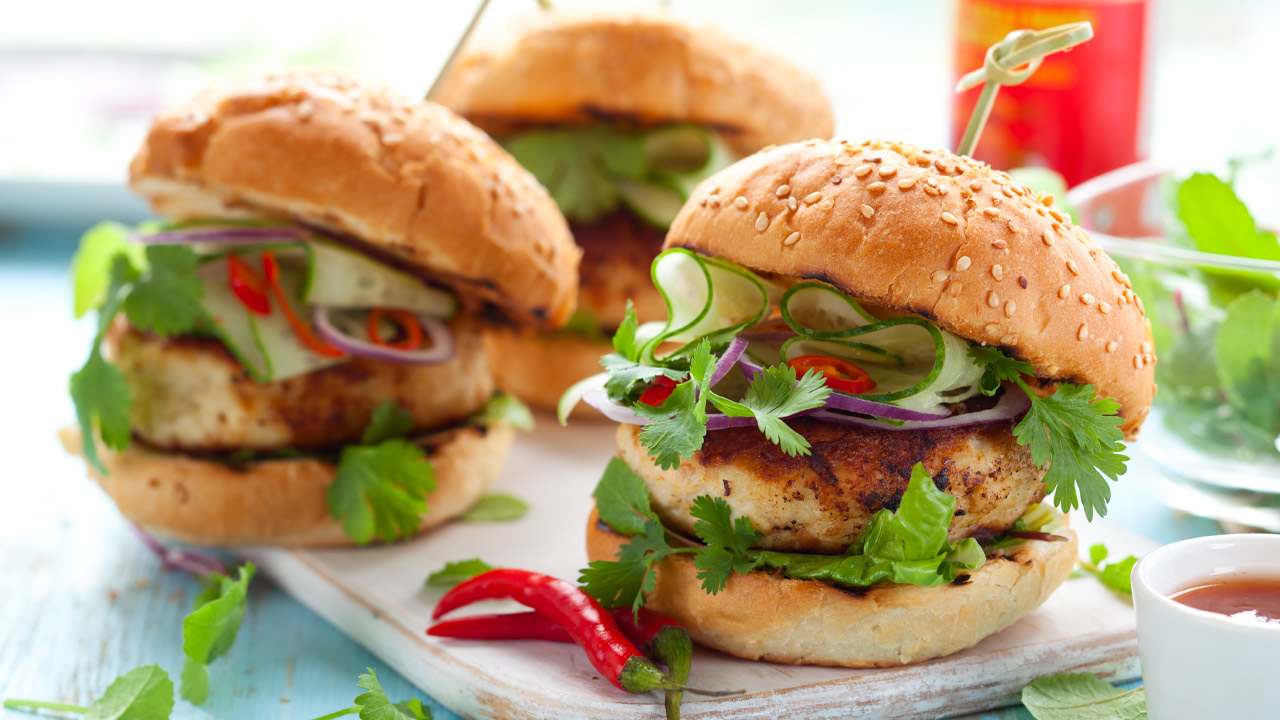The Anatomy of a Healthy Burger

Hey Angels and Alphas,
In the world of nutrition, burgers have a reputation for being something you crave, not really something that can be nutritious, filling, or even a weight-loss-promoting meal.
But all the pros know that, when prepared correctly, a burger can be all of that and more!
Not all burgers are created equal – a burger can indeed be a healthy and nutritious meal if done right. Your choice of burger, bun, topping, and condiment is going to make all the difference.
That’s why today, we’re here to break down how to make a healthy and nutritious burger that can actually help you move forward toward your goals instead of being labeled as a “bad” food.
LET’S START WITH THE BUN
First of all, aim for whole grains.
When you’re at the grocery store, skip past the while flour-based buns and go for the whole grain buns. Whole grain hamburger buns are made from sprouted whole grains like red wheat, millet, quinoa, and come with a higher fiber content. A whole-grain bun can also provide you with extra protein, which is especially handy if you’re eating a burger that’s bean-based or you’re looking to sneak in more of that filling, muscle-powering ingredient.
What about lettuce wrap?
If you want to go low-carb or you’re just looking to leave room for those delicious sweet potato fries, then those lettuce-wrapped burgers can be your best option. Lettuce perfectly fits in burgers due to its size, but if you can’t find any, collard greens do an amazing job, as well.
MOVING ON TO THE BURGER
Don’t go easy on the meat. After all, it’s a burger.
Some of your best choices for lean protein include turkey and chicken. But that doesn’t mean you have to forget about lean ground beef. When shopping, try to look for meat that has a high leanness percentage, usually over 90 percent. You can even find ground beef with about 95 percent leanness. That being said, you should still go easy on it – don’t consume red meat more than 1-2 times a week.
Don’t forget about the beans.
Veggie-based and bean burgers can be made from a plethora of lentils and beans, such as black beans, white beans, chickpeas, and more. You can make these at home or find them in the frozen section at your local grocery store. If you can, opt for a bean burger that contains at least 5 grams of protein per burger so you can feel satiated and satisfied.
And don’t be afraid to go fish.
Fatty fish such as salmon is an amazing option for fish-based burgers because it stays juicy when grilled. Salmon burgers are a wonderful way to get in healthy omega-3 fatty acids as well as a ton of protein.
NEXT, ON TO THE TOPPING
Veggies, veggies, veggies.
Lettuce and tomato are the go-to classics… but you can still get creative. Every burger is an opportunity to pile on more and more veggies. Sauerkraut, aragula, and caramelized onions are all great options to kick up the flavor of your burger. You can also try microgreens, sauteed mushrooms, grilled zucchini, poblano pepper, and more.
Bring on the healthy fats!
Avocado and guacamole slices can provide abundant sources of heart-healthy fats. A quarter of avocado supplies about 80 calories, so you should just grab that and smash your avocado directly on the bun so you make eating it a bit less messy.
What about cheese?
Choosing the perfect cheese to accompany your burger is an art form. Sliced cheddar, swiss, goat cheese, blue cheese – all great options. 1 ounce of cheese will add about 100 calories to your burger. And did you know a 2016 study published in the journal Nutrients found that dairy foods such as cheese help preserve lean muscle in calorie-restricted diets? If you’re looking to lighten things up, go for the thin-sliced cheese found in grocery stores. It’s still flavorful but packs on fewer calories. Score!
FINALLY, THE CONDIMENTS
Mustard. Whether it’s yellow, Dijon mustard, spicy mustard, or any type of mustard that tickles your fancy, mustard is a go-to to add flavor to your burger. You can also mix and match the different types of cheese and mustard to keep things extra interesting.
Hot sauce. Be careful here – hot sauce can be an amazing add to your burger, but make sure you choose a hot sauce that’s as low in sodium as possible.
Hummus/tzatziki. Tzatziki is a yogurt-based dip made with cucumber, and along with hummus, it makes mayo look irrelevant.
Pico de gallo. Pico de gallo is a condiment made with onions, peppers, and chopped tomatoes, and it’s one of the best ways to add freshness to your burger… especially on those hot summer days.




